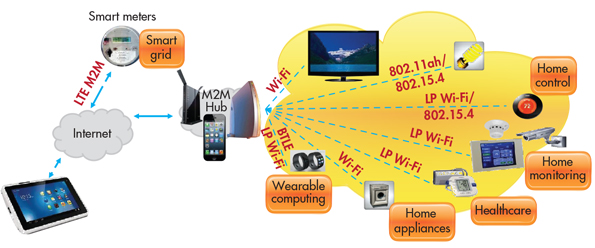



Feature Story
More feature stories by year:
2024
2023
2022
2021
2020
2019
2018
2017
2016
2015
2014
2013
2012
2011
2010
2009
2008
2007
2006
2005
2004
2003
2002
2001
2000
1999
1998
 Return to: 2015 Feature Stories
Return to: 2015 Feature Stories
CLIENT: IMAGINATION TECHNOLOGIES
Oct. 13, 2015: Electronic Design
Imagination's Richard Edgar talks to Technology Editor Bill Wong about tomorrow's 5G world—technology/market challenges, the future for wireless standards targeting 5G, and the IoT market's impact on 5G.
Looming on the horizon is 5G. It will provide improved performance and capacity, but there are inherent design challenges to this new technology. Though 4G is already used for Internet of Things (IoT) applications, 5G will be needed to handle the wave of new products.
I talked with Richard Edgar, Director of Communications Technology for Imagination, about 5G's technology and market challenges, and how Imagination is addressing these issues.
Wong: What do you see as the key technology/market challenges and opportunities for 5G?
Edgar: One key challenge for 5G will be efficiently using the spectrum that will be available for 5G—it's currently challenging to design a communications standard that performs well across a wide 600-MHz to 80-GHz spectrum range that's discussed now for 5G. Consumers also expect their content everywhere, streamed from the cloud, from smartphones, smartwatches, tablets. So multimedia, home automation, security, and eHealth must all join up and work seamlessly.
Wong: What is the impact of the IoT market on 5G?
Edgar: The impact of the IoT market on 5G will be huge. Integration of connectivity such as low-power Wi-Fi and Bluetooth Smart onto the SoC is key to achieving lower power and low-cost devices for IoT. With 5G, we'll most likely see several connectivity standards that will coexist, so solutions must address multiple standards and be designed for power efficiency.
Imagination's Ensigma Whisper radio processing units (RPUs), for instance, are designed to be highly configurable to give designers the flexibility to offer multi-standard support in a single architecture. Whisper connectivity IP is designed so that customers can choose to integrate Wi-Fi 802.11n, Bluetooth Smart, 802.15.4 such as 6LowPan, Zigbee, or Thread, or a combination of the standards, depending on their specific application (Fig. 1).

1. Imagination's Ensigma Whisper radio processing units make it possible to integrate one or multiple standards, such as Bluetooth Smart, Wi-Fi 802.11n, ZigBee, and others.
Wong: What do you see in the future for wireless standard(s) for 5G? Is it feasible for one standard to cover all use cases?
Edgar: Today we have a welter of standards for different applications. Examples of these standards include 802.15.4, Bluetooth Smart (BTLE), and Low Power Wi-Fi – 1x1 802.11n. Proponents of 5G are looking for one "standard" to encompass use cases such as cellular, IoT, WAN, LAN, PAN, and more. There's a lot of discussion now centering on whether one single standard could ultimately replace all other wireless technologies, particularly LAN technologies such as Wi-Fi. Whether it's possible—or sensible—is still being debated, and itwill continue to be for the foreseeable future.
Wong: If multiple standards are on the 5G horizon, will carriers then use a combination of licensed/unlicensed technologies such as Wi-Fi to provide an "always-on experience" for consumers?
Edgar: Initially we'll probably see this. Consumers just want the technology to always work. It might also alleviate some pressure off carriers' existing cellular networks.
Wong: With the wide range of potential spectrum available for 5G, what new techniques will be needed in cellular-radio design—will cognitive-based software-defined radio (SDR) technology, for instance, be one way forward?
Edgar: Cognitive radio is definitely a promising way forward. Moving the decision-making back into the network and away from the center could be an important differentiator for IoT.
Wong: Describe some of the different markets, and different priorities, in a 5G world.
Edgar: Prior generations of network technology have been very voice-centric, with data as an add-on. 5G brings data to the heart of the network. With 5G, we'll see better efficiency and robustness. In connecting the world of IoT, sizable deployments of IoT devices will be in rural and sparsely populated regions of the world. We'll see an extensive array of market opportunities and applications, including home automation, wearables, surveillance, transportation, and agriculture. Priorities include greater system capacity, reduced latency, energy savings, and higher data rates (Fig. 2). And all will have improved robustness.

2. We'll see an extensive array of market opportunities and applications, including home automation, wearables, surveillance, transportation, and agriculture. Priorities include greater system capacity, reduced latency, energy savings, and higher data rates.
Wong: How do you see all the disparate alliances coming together on 5G?
Edgar: It's still pretty early in the game, but I'm sure—at least I certainly hope so—that a number of key alliances and consortiums will sort out commonalities to further ensure a smooth transition to 5G. Imagination, for instance, launched the prpl Foundation last year. It's open-source, community-driven, collaborative, and in addition to embedded/IoT, other initial domains include connected consumer, data center, and networking and storage.
As we focus on contributing to the definition and development of 5G, both internally and through organizations such as the 5G Innovation Centre (5GIC) at the University of Surrey, we can see that there is a lot of room for innovation across the ecosystem.
Wong: What can companies do to future-proof their designs as 5G is defined over the coming several years?
Edgar: The bar is going to be very high. Companies need to develop products with multi-standard support to future-proof their designs; they must also be cognizant that consumers want instant access to the Internet, email, and social-media channels. The digital home revolution is already underway—everything is going wireless—and everything has to work together.
Return to: 2015 Feature Stories